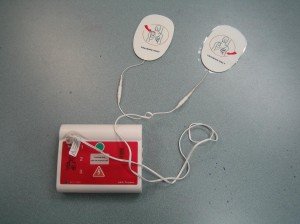Defibrillation or electrical cardioversion is a procedure in which a brief electric shock is delivered to the heart to reset the heart rhythm to normal. The shock is given via patches applied on the exterior of the chest wall. In some cases, an external defibrillator that has paddles can be used.
In most instances, the individual is sedated. In case the individual is conscious, medication is given to control the pain and promotes relaxation to a point of almost being unconscious during the procedure.
What to expect after
After defibrillation, the heart rate and blood pressure are monitored. Medications to prevent issues with the heart rhythm from recurring can be given before and after the procedure. In case antiarrhythmic medications are not given after the procedure, the heart is at high risk for having a rapid heart rate again.
After defibrillation, a blood thinner might be used such as warfarin for a few weeks to prevent the formation of clots.

Why is defibrillation done?
Defibrillation might be utilized as an emergency technique to cease a rapid heart rate responsible for triggering low blood pressure or other significant symptoms. The issues with the heart rate include:
- Atrial fibrillation
- Ventricular tachycardia
- Supraventricular tachycardia
It is important to note that defibrillation is highly effective. Many individuals who receive defibrillation return to their normal sinus rhythm right away.
Are there possible risks?
The potential risks of the procedure might include the following:
- Breaking away of the blood clot from the heart that can result to a stroke. The doctor will attempt to reduce this risk with anticoagulants or other measures.
- In some cases, the procedure might not work. Another round of defibrillation or other treatment might be required.
- Antiarrhythmic medications used before and after the procedure or even defibrillation itself might result to a dangerous erratic heartbeat.
- The individual might end up with a reaction to the sedative given prior to the procedure.
- A small-sized burn on the skin in which the patches or paddles are placed.
Quick Note / Disclaimer
The material posted on this page on defibrillation is for learning and educational purposes only. To learn more about defibrillation and when it is needed, register for a first aid and CPR course with one of our training providers.
